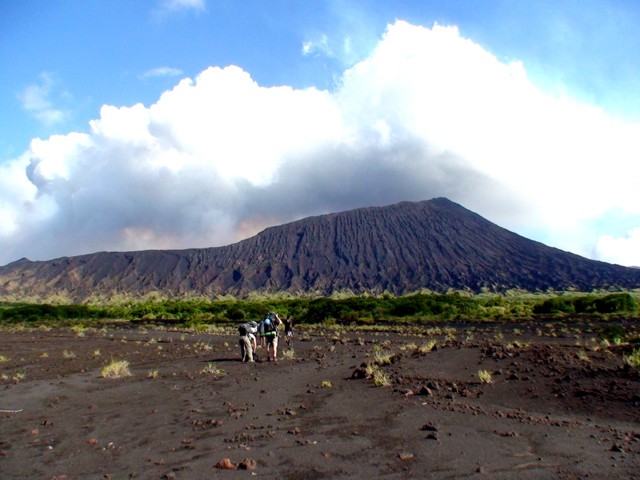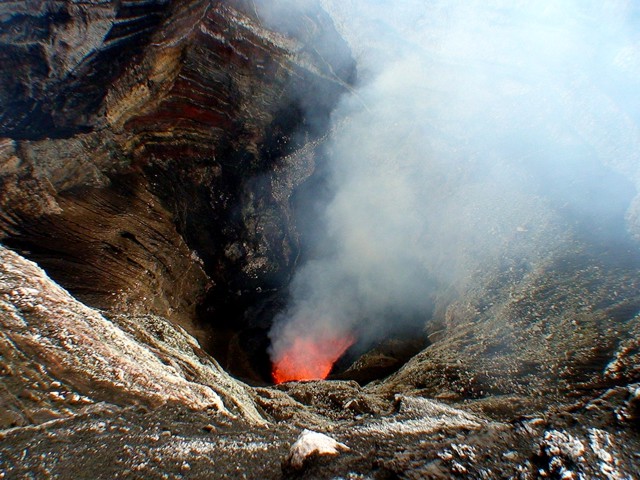Report on Ambrym (Vanuatu) — May 2007
Bulletin of the Global Volcanism Network, vol. 32, no. 5 (May 2007)
Managing Editor: Edward Venzke.
Ambrym (Vanuatu) Lava lakes active again starting in January 2007; ash plumes
Please cite this report as:
Global Volcanism Program, 2007. Report on Ambrym (Vanuatu) (Venzke, E., ed.). Bulletin of the Global Volcanism Network, 32:5. Smithsonian Institution. https://doi.org/10.5479/si.GVP.BGVN200705-257040
Ambrym
Vanuatu
16.25°S, 168.12°E; summit elev. 1334 m
All times are local (unless otherwise noted)
Thermal anomalies detected by the MODIS satellite instrument showed that the lava lakes present in Benbow and Marum craters, which have been almost continuously active since early 2001 (BGVN 29:06), continued until 19 June 2005. Ash had apparently stopped falling on 1 June, though a haze of SO2 was noted on 17 June (BGVN 30:05). Thermal anomalies were not regularly seen again until 11 January 2007. The only exceptions occurred from Benbow on 14 April 2006 (one pixel) and from Marum on 8 and 15 November 2006 (one and two pixels, respectively). Thermal anomalies were seen on 11 and 15 January, again during 3-19 February, and then almost daily after 9 March through at least the end of May. The current lava-lake activity, as determined by MODIS data, seems to be confined to the Marum crater area.
The Wellington Volcanic Ash Advisory Center (VAAC) reported that on 3 April 2007 pilots observed lava and ash emissions from Ambrym; ash plumes rose to altitudes below 2.4 km. On 1 May at 1330 satellite imagery showed an ash cloud with NE winds at the surface turning to NW above an altitude of 3 km. On next day at 0715 a pilot observed a vertical plume extending 37 km NW at an altitude of 4 km. On 3 May at 0900 a pilot identified an ash cloud below an atmospheric temperature inversion at an altitude of -1.8 km drifting SE. Ash was visible on satellite imagery at 1310 on 3 May.
Steven Clegg and Kelby Hicks reported that the volcano continued to exhibit strong degassing from both Marum (figure 16) and Benbow vents from 26 May to 12 June 2007. Within the Mbwelesu crater a lava lake appeared in May 2007, while the group was there, and continued to be visible through 12 June (figure 17). Fumarolic activity was visible throughout the interior of Mbwelesu Crater with intermittent ash eruptions and light tephra emissions. Extra-crater tephra fall included Pele's Hair, reticulite, spatter, and scoria-sized ejecta. Both Niri Mbwelesu and Mbogon Niri Mbwelesu (formerly Niri Mbwelesu Taten) craters exhibited notable fumarolic degassing, but no other observable activity. No lava lake could be seen from the rim of Benbow crater; however, a strong glow above Benbow was visible during night observations.
 |
Figure 16. View of the Marum cone at Ambrym looking SW, 7 June 2007. Incandescence from the active lava lakes can be seen reflected in the clouds (left). Courtesy of Steven Clegg. |
 |
Figure 17. Lava lake inside Mbwelesu crater within Marum cone at Ambrym, 7 June 2007. Courtesy of Steven Clegg. |
Geological Summary. Ambrym, a large basaltic volcano with a 12-km-wide caldera, is one of the most active volcanoes of the New Hebrides Arc. A thick, almost exclusively pyroclastic sequence, initially dacitic then basaltic, overlies lava flows of a pre-caldera shield volcano. The caldera was formed during a major Plinian eruption with dacitic pyroclastic flows about 1,900 years ago. Post-caldera eruptions, primarily from Marum and Benbow cones, have partially filled the caldera floor and produced lava flows that ponded on the floor or overflowed through gaps in the caldera rim. Post-caldera eruptions have also formed a series of scoria cones and maars along a fissure system oriented ENE-WSW. Eruptions have apparently occurred almost yearly during historical time from cones within the caldera or from flank vents. However, from 1850 to 1950, reporting was mostly limited to extra-caldera eruptions that would have affected local populations.
Information Contacts: Steven G. Clegg and Kelby E. Hicks, Volcan, Inc., P.O. Box 1287, Austin, TX 78767, USA (URL: http://www.volcan.org/); Wellington Volcanic Ash Advisory Centre (VAAC), Meteorological Service of New Zealand Ltd (MetService), PO Box 722, Wellington, New Zealand (URL: http://www.metservice.com/vaac/, http://vaac.metservice.com/); Hawai'i Institute of Geophysics and Planetology (HIGP) Thermal Alerts System, School of Ocean and Earth Science and Technology (SOEST), Univ. of Hawai'i, 2525 Correa Road, Honolulu, HI 96822, USA (URL: http://modis.higp.hawaii.edu/).

